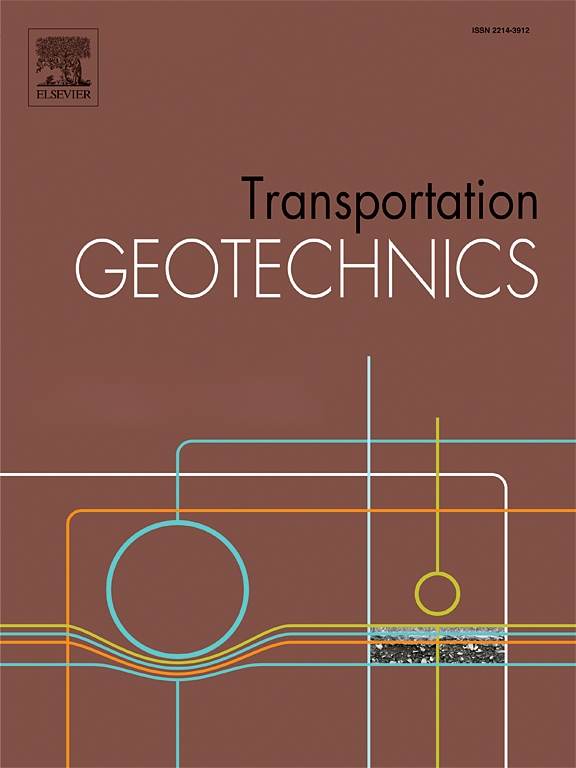深层搅拌法改良有机土壤强度演化的室内研究
IF 5.5
2区 工程技术
Q1 ENGINEERING, CIVIL
引用次数: 0
摘要
研究了深层土壤混合(DSM)对提高有机土壤强度和模量的有效性。该研究评估了不同水泥类型、粘合剂用量、水灰比(w/c)和养护时间对两种不同有机土壤力学特性的影响;来自伊斯坦布尔金角地区的有机含量为12.4%的天然土壤,以及由高岭土和莱纳迪石50/50的混合物制成的人造土壤,由于有机含量高,pH值呈酸性。这些标本被处理了四个时间,从7天到1年不等。测试程序包括力学测试;无侧限压缩试验(UCS)、超声脉冲速度(UPV)测量和化学分析;x射线荧光(XRF)和热重分析(TGA)。UCS试验表明,较高的粘结剂用量和延长的固化时间显著提高了强度。较高的w/c比导致强度下降。较长的固化时间导致强度值是28天强度值的四倍。通过“固化时间效应指数(fc)”来评价这种在较长持续时间内强度增加的放大效应。分别从水泥掺量效应、水泥类型效应、总水灰比(wt/c)效应、标准差值、E50值、养护时间效应指数(fc)等方面给出了结果。UPV试验的结果用于开发强度和超声脉冲速度之间的相关性。利用XRF和TGA分析结果和强度进行定量评价。在机械和化学分析方面产生了大量的数据。本文章由计算机程序翻译,如有差异,请以英文原文为准。
Laboratory investigation of strength evolution in organic soils improved by deep mixing method
This study investigates the effectiveness of deep soil mixing (DSM) in enhancing the strength and modulus of organic soils. The research evaluates how varying cement types, binder dosages, water-to-cement (w/c) ratios, and curing durations affect the mechanical properties of two different organic soils that were used; natural soil from the Golden Horn region of Istanbul with 12.4% organic content, and an artificial soil created from a 50/50 mixture of Kaolin clay and Leonardite, which has an acidic pH due to high organic content. The specimens were cured for four durations, ranging from seven days to one year. The testing program included mechanical testing; Unconfined Compression Tests (UCS), Ultrasonic Pulse Velocity (UPV) measurements, and chemical analyses; X-Ray Fluorescence (XRF) and Thermogravimetric analyses (TGA). The UCS tests indicated that higher binder dosages and extended curing durations significantly improved the strength. Higher w/c ratios resulted in decreased strength. Long curing durations resulted in strength values which were four times the 28-day strength values. This amplified effect of strength gain in longer durations was evaluated through “Curing time effect index, (fc)”. The results were presented in terms of cement dosage effect, effect of cement type, effect of total water/cement ratio (wt/c), standard deviation values, E50 values and curing time effect index (fc) values respectively. Results of UPV tests were used to develop correlations between strength and ultrasonic pulse velocities. Quantitative evaluations were made using the results of XRF and TGA analyses and strength. Significant amount of data was produced both in terms of mechanical of chemical analyses.
求助全文
通过发布文献求助,成功后即可免费获取论文全文。
去求助
来源期刊

Transportation Geotechnics
Social Sciences-Transportation
CiteScore
8.10
自引率
11.30%
发文量
194
审稿时长
51 days
期刊介绍:
Transportation Geotechnics is a journal dedicated to publishing high-quality, theoretical, and applied papers that cover all facets of geotechnics for transportation infrastructure such as roads, highways, railways, underground railways, airfields, and waterways. The journal places a special emphasis on case studies that present original work relevant to the sustainable construction of transportation infrastructure. The scope of topics it addresses includes the geotechnical properties of geomaterials for sustainable and rational design and construction, the behavior of compacted and stabilized geomaterials, the use of geosynthetics and reinforcement in constructed layers and interlayers, ground improvement and slope stability for transportation infrastructures, compaction technology and management, maintenance technology, the impact of climate, embankments for highways and high-speed trains, transition zones, dredging, underwater geotechnics for infrastructure purposes, and the modeling of multi-layered structures and supporting ground under dynamic and repeated loads.
 求助内容:
求助内容: 应助结果提醒方式:
应助结果提醒方式:


